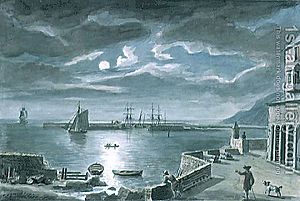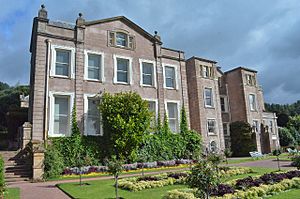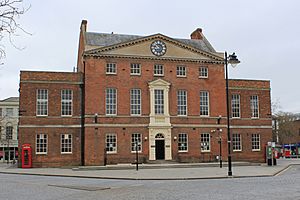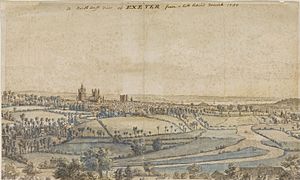Coplestone Warre Bampfylde facts for kids

Coplestone Warre Bampfylde (1720–1791) was a talented British man who lived a long time ago. He was a landowner, which means he owned a lot of land. He was also a skilled garden designer and an artist.
Contents
Who Was Coplestone Warre Bampfylde?
Coplestone Warre Bampfylde was born in 1720. He was the only son of John Bampfylde. His mother was Margaret, who inherited a lot of property from her father, Sir Francis Warre.
Coplestone went to two well-known schools: Blundell's School and Winchester College.
Hestercombe House and Gardens
In 1750, Coplestone's father passed away. Coplestone then inherited Hestercombe House in Somerset. This beautiful house and its land originally belonged to his mother's family.
At Hestercombe, Coplestone used his creative skills to design and create amazing gardens. These gardens are very special. Today, they are recognized as a Grade 1 historic site by English Heritage. This means they are very important and protected.
Military Service
Coplestone also served in the military. In November 1758, during a big war called the Seven Years' War, he became a Major in the 1st Somerset Militia. A militia was like a local army that helped defend the country.
His regiment was called to full-time duty in July 1759 to protect England. They served in the defenses of Plymouth. In December 1761, Coplestone was promoted to Lieutenant-Colonel. His regiment finished its service in December 1762 when the war ended.
Later, in June 1797, he was made Colonel of the Regiment.
An Artist and Designer
Coplestone Warre Bampfylde was a very good amateur painter. An amateur painter is someone who paints for enjoyment, not as their main job. He showed his artwork in several important exhibitions, including the Society of Artists and the Royal Academy, between 1763 and 1783.
He also made some etchings, which are like prints, of landscapes. He even drew funny pictures for a book called Election Ball by Christopher Anstey. These drawings were later made into prints by William Hassel.
Besides his art, Coplestone also designed buildings. In 1772, he designed the Market House in Taunton.
Later Life and Legacy
Coplestone Warre Bampfylde passed away at Hestercombe on August 29, 1791. He was buried in his family's tomb at St Mary's Church, Kingston.
He was married to Mary Knight, but they did not have any children. After he died, Hestercombe House was left to his nephew, John Tyndale.
Today, you can still see paintings by Coplestone Warre Bampfylde in important collections. Some of his artworks are held by the National Trust, the UK Government, and Exeter University.




